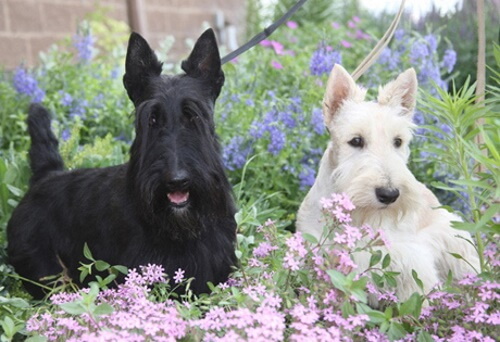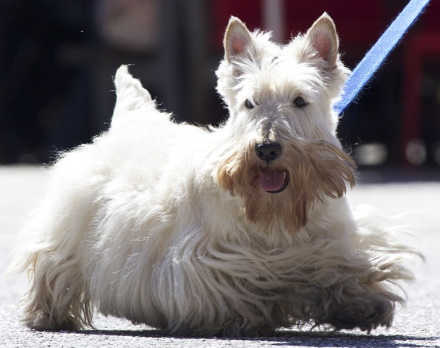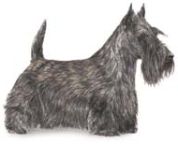Scottish Terrier Dogs
Sensitive, Loyal And Devoted!
Scottish Terrier dogs were formerly known as an Aberdeen Terriers or
Broken-haired Terriers and originated in the rocky highlands of
Scotland.
 Moola and Fluffy courtesy Creative Commons
Moola and Fluffy courtesy Creative CommonsAt the time of their development, many different terriers were loosely grouped together as Scottish Terriers - not as specific breeds. Which ones contributed to the Scottie dogs as we know them today is unclear, though the Skye, Dandie Dinmont, West Highland and Cairn, are likely relatives. It wasn't until l883 that a movement was organized among owners and a standard written, to distinguish the breed.
The Scottie is a hardy and courageous breed that worked on the farm
hunting and exterminating small animals in their dens, particularly the
fox.
He is a handsome and sturdy dog with a keen and inquiring expression.
Although muscular and short-legged, he is quite agile. He has good
intelligence and worked independently within his territory getting the
job done.
Barney and Miss Beazley are two Scotties that enjoyed living in the White House with former President and Mrs George W. Bush.
Other famous owners of this breed, include Presidents Franklin Roosevelt, Dwight Eisenhower, and Ronald Reagan, Queen Victoria, Bette Davis, Humphrey Bogart, Zsa Zsa Gabor, and Charles Lindbergh.
Characteristics of the Scottie
Little though he is, there is a lot of big dog personality about him and a great deal of intelligence. Some
say he is a bit stubborn, others say tenacious.
It is not so surprising that some of these character traits have
carried over from his tough working days when this little guy had to be independent and bold if he wanted to
keep his job! These same traits have helped make him a good watchdog today.
 Courtesy Tesa Photography
Courtesy Tesa PhotographyMany owners credit Scottish Terrier dogs as having the utmost loyalty to their family, as well as being affectionate and playful.
Although you will have to establish yourself in the dominant role and may have to spend a wee bit more time getting your point across during training, he will come around.
Remember, he really wants to learn - those darn dominant traits just keep getting in the way. But don't be harsh with him - he is a very sensitive dog and will do so much better with a gentle yet consistent approach.
Scotties enjoy the outdoors. If you have property, be sure to secure any possible escape routes as his hunting instinct is strong and he can be a digger.
Physical Stats And Care

Height: 10-11 inches
Weight: 23-27 lbs.
Color variations: Black, Wheaten and Brindle of any shade
Scottish Terrier dogs are double-coated. The weatherproof coat is harsh
and dense on the top and soft underneath providing good warmth and
protection in the often chilly weather of their native Scottish climate.
Maintenance of the coat should include regular brushing and
periodic stripping. Clipping the coat is another option if the dog is
not going to be presented in dog shows, but will change the natural wiry
texture to a softer coat.
Health Profile of Scottish Terrier Dogs
Scottish Terrier dogs have a greater health risk than other dog breeds to various forms of cancer and in
particular, bladder cancer.
Others diseases that may affect the breed are:
- Scottie Cramp,
- Craniomandibular osteopathy also known as Scottie Jaw, and
- Type I von Willebrand's disease.
Because of this breed's greater cancer risk, more care is needed to avoid his exposure to chemicals
that may be used around the yard and garden including herbicides and pesticides.

Plus if the Scottie should need to be treated for parasites, the natural
flea remedies are preferred over the chemical-based products. In fact
we believe all pets should be treated likewise and have written an
extensive article about the natural ways to
control dog fleas, here.
Cigarette smoke and solvents are other substances from which the Scottie
should be protected due to their potential for carcinogenic
effects.
Pet professionals suggest that the Scottie should be fed a cancer-protective diet.
Such a diet would be of
high quality, vitamin rich and one which includes leafy green or yellow-orange vegetables at least three times a week.
This could potentially lessen the risk of developing bladder cancer by 70% to 90%. Well worth the effort I would say!
How Active are Scottish Terrier Dogs?
This breed is moderately active in the home, but being from a working dog background, a daily walk is needed to complete his exercise requirements and will make him a much happier and healthier pet.
An outside area where he can play is nice alternative on non-walk days, but be sure to maintain secure fencing to prevent this avid digger from escaping!
Ideal Living Space
Scottish Terrier dogs will adapt to almost any environment, but a house with a yard where they can run is the best choice.
The Scottie With Children?
Does best with older considerate children who have been taught how to handle pets. Terriers, as with most dogs, do not take kindly to mishandling.
Scotties need to be well-socialized to be in a family with
children and other pets.
The best policy, no matter what the breed, is to have adult supervision whenever pets and children are
are interacting.
Senior Or Less active Families?
Scottish Terrier dogs especially enjoy companionship and being well-loved members of the family.
They do really well with the seniors and the close attention they usually get. Plus they are good watchdogs and
their exercise needs are not too hard for less active families to meet.
Further Reading

The Complete Guide to Scottish Terriers
Comprehensive guide to Finding, Training, Socializing, Feeding, Grooming, and Loving your new Scottie Dog. Also includes history and health information.
Moola and Fluffy image: commons.wikimedia.org/wiki/File:Scottish_Terriers.jpg License:CC BY 2.0 via Wikimedia Commons

